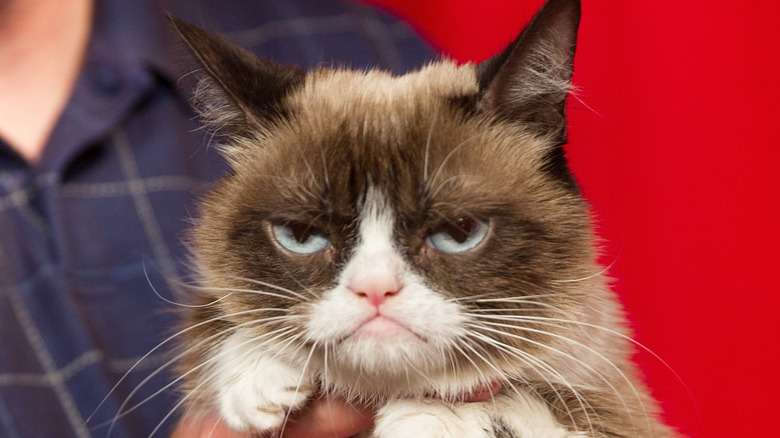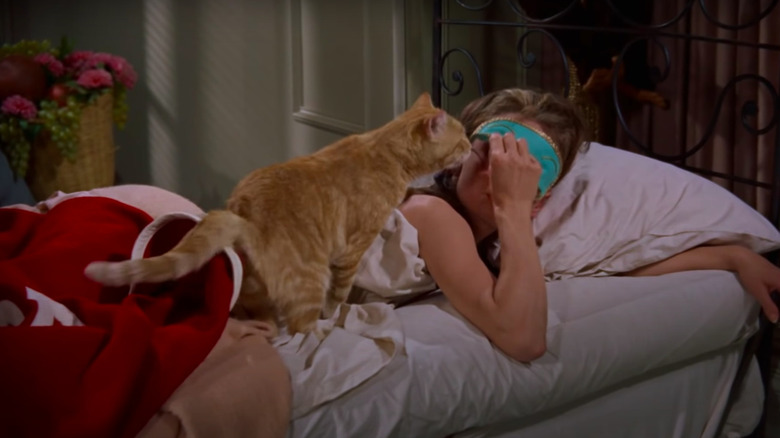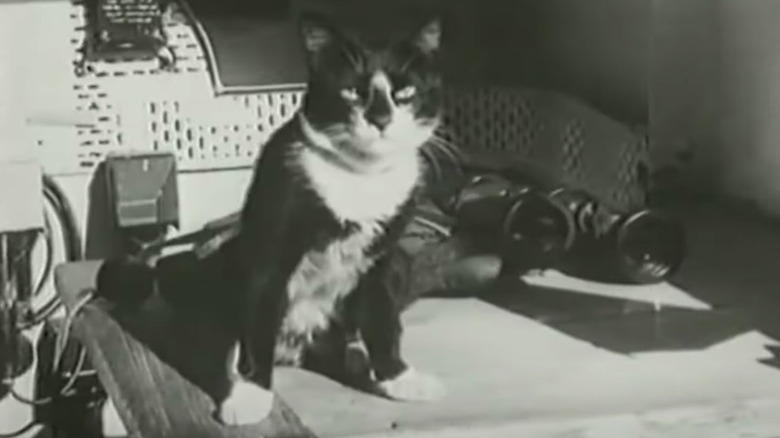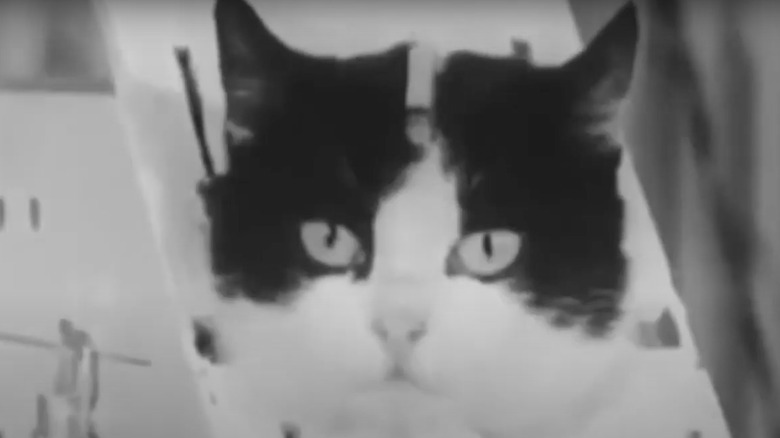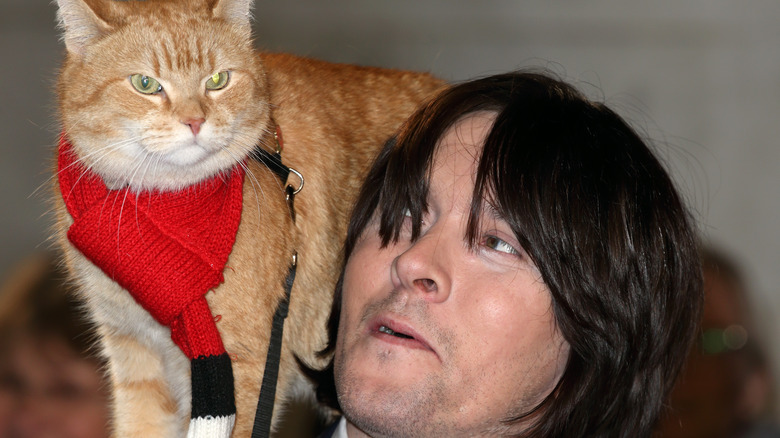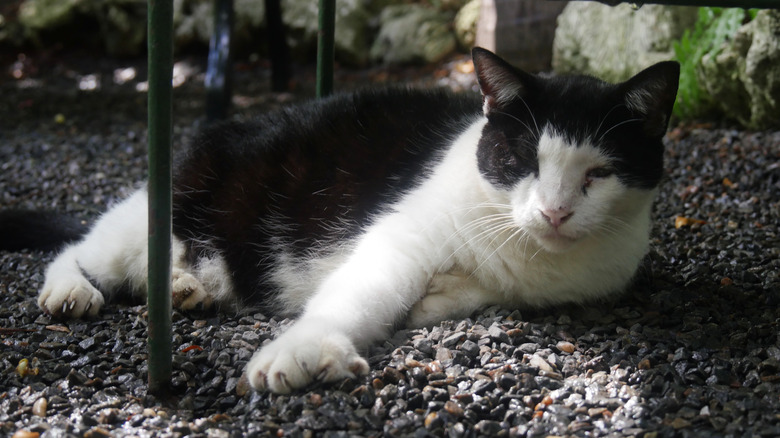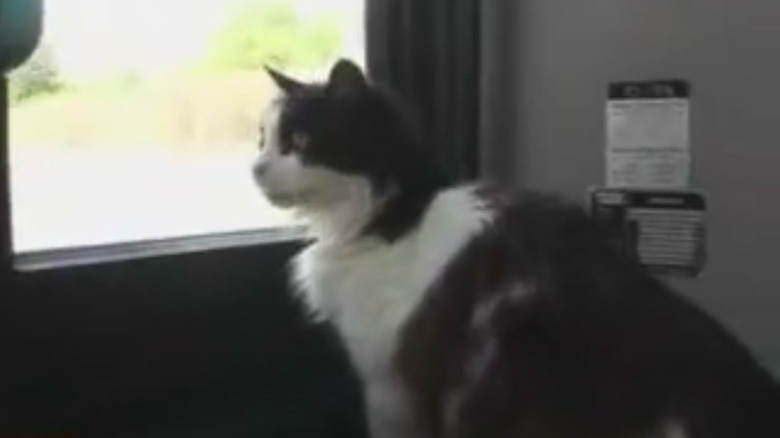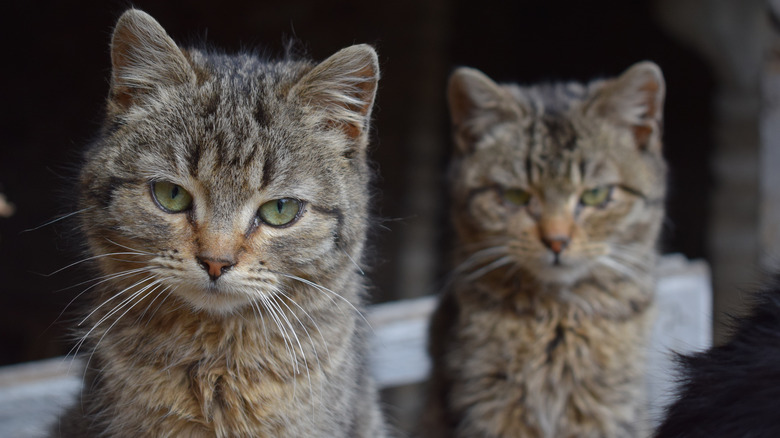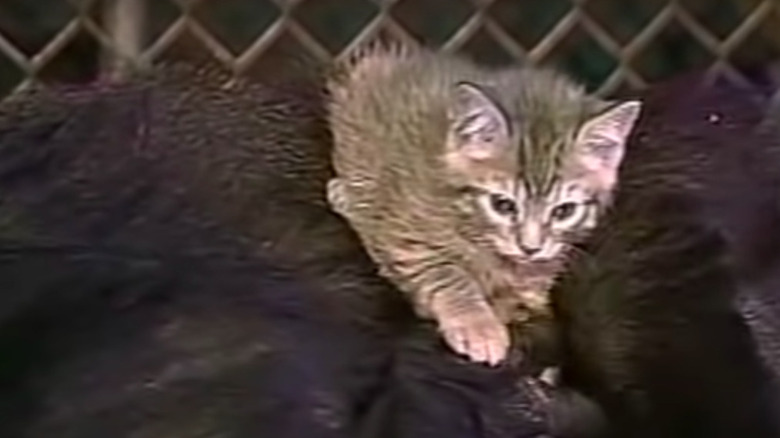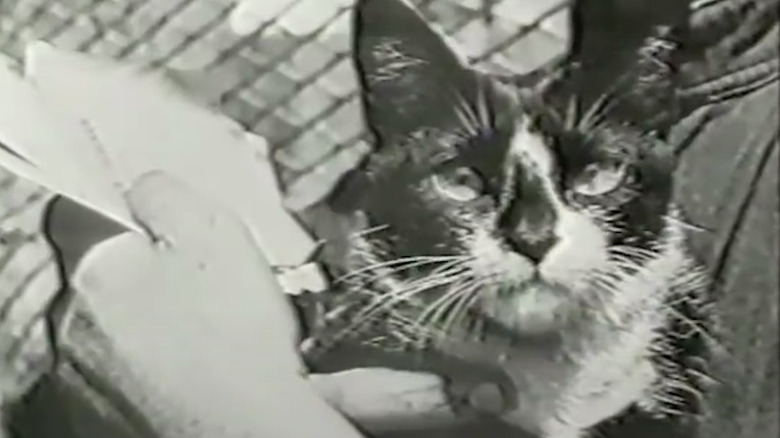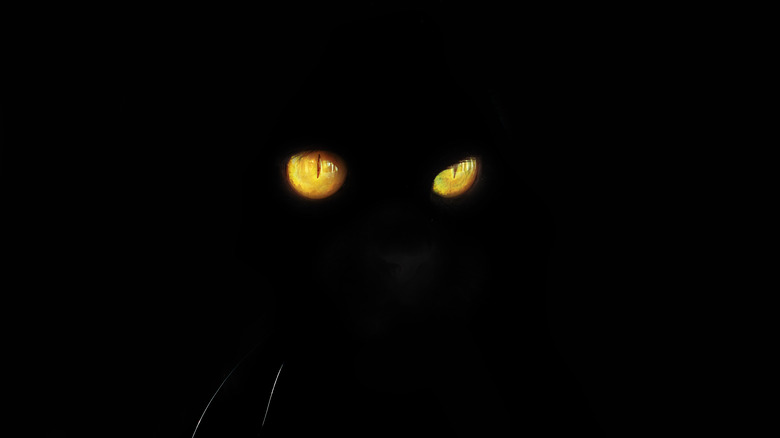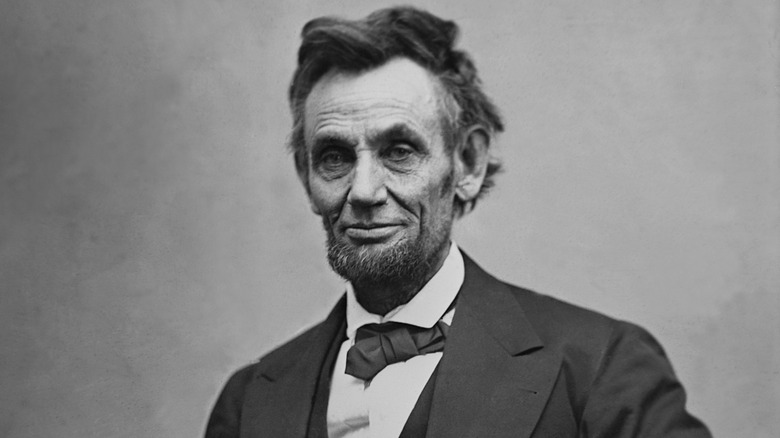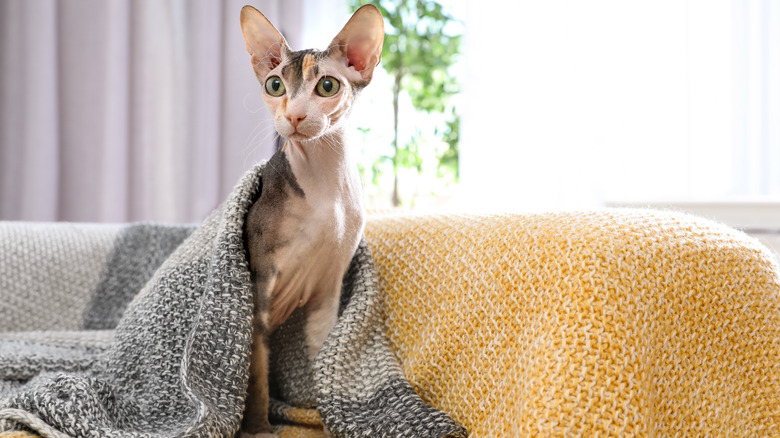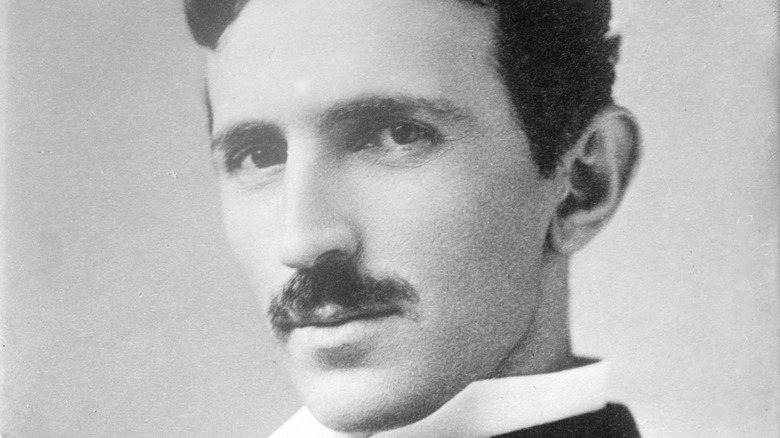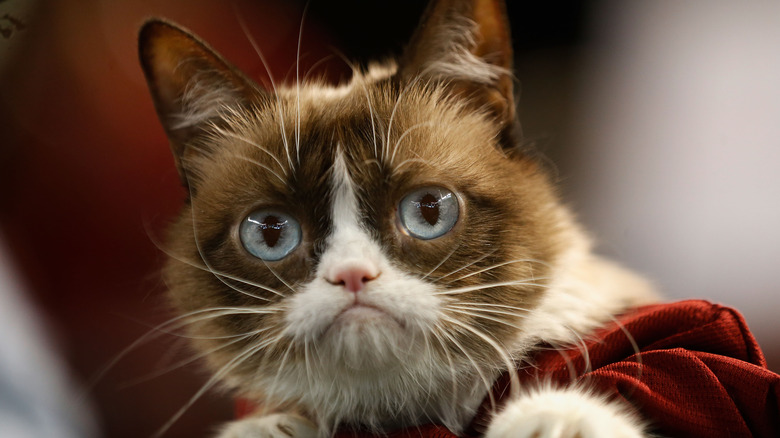The Most Famous Cats In History
Humans have been obsessed with cats for what seems like eternity. Ancient Egyptians worshipped cats, "associating [them] to specific deities" (via Smithsonian Magazine), while ferocious Vikings took the sometimes-cuddly creatures on seafaring adventures. In Islam, it is believed that the Prophet Muhammad had a cat, Muezza, and when he found her sleeping on the sleeve of his robe, he used scissors to cut around her, tearing his garments instead of disturbing her (via Kashmir Observer).
These days, as revealed by National Geographic, there are over 80 million felines in the U.S. and approximately three cats for every dog in the world. And while cats are known to be much more aloof and independent than their canine counterparts, sometimes they surprise us. According to the Washington Post, while "no one has bred cats to guard houses, herd livestock or assist hunters," some felines have done some pretty incredible things — and they'll make you question who truly is man's best friend. Let's look at the most famous cats in history.
Orangey the acting diva
Was Audrey Hepburn really the star of "Breakfast at Tiffany's"? Sure, her portrayal of Holly Golightly captured the hearts of countless viewers, but many fell just as much in love with her adorable marmalade-colored tabby kitty, simply named Cat. Cat was played by Orangey, and, believe it or not, he was a major motion picture star of the '50s and '60s.
Orangey's IMDb credits are impressive, and the furry thespian worked on some big-name productions, including the Oscar-nominated "Gigot" and "The Beverly Hillbillies." Orangey was already a seasoned pro by the time he became Hepburn's sidekick, and he had the A-list personality to go with his success. According to "Cats' Most Wanted," a movie executive once dubbed him "the world's meanest cat," as he was known to get aggressive with his co-stars, "scratching and spitting after a scene was complete." He even gave notorious diva Faye Dunaway a run for her money, often simply walking off set and halting production until the crew could wrangle him back.
Despite him certainly not being a good boy, it appears that Hepburn, who was famous for her love of animals, had a soft spot for Orangey. Per "Uncle John's Bathroom Reader Cat Lover's Companion," Hepburn described the heated scene where she tosses her pet into the pouring rain as one of the most "distasteful things" she was ever asked to do on camera.
Unsinkable Sam quickly worked through his nine lives
In the spring of 1941, the Bismarck, a German battleship, set sail towards the North Atlantic, tasked with the duty to "attack the vast naval convoys" that carried important supplies from North America to Great Britain (via "100 Cats Who Changed Civilization"). While many considered the Bismarck a leading warship of World War II, it didn't stop the British Royal Navy from jumping into battle and attacking the German behemoth right as it set sail. As the story goes, after viciously fighting for three days, the Bismarck was finally defeated, with only a few crewmembers surviving — including one lucky cat.
The Bismarck's black and white kitty, Oscar, was brought on board the opposing ship, the HMS Cossack, and renamed Unsinkable Sam. His new name was appropriate for him, as a mere five months into sailing with the Cossack, the ship was sunk by a German submarine, with Sam miraculously surviving yet again. He was then taken aboard the HMS Ark Royal, where Sam truly tested how many of his lives he had left and got away from yet another torpedoing, finally slinking onto the HMS Legion. It seems that authorities finally took pity on poor Sam and brought him to shore so he could retire from his naval career.
As noted by Jura, Sam landed the job of his life as a mouse-catcher in the office of the Governor-General of Gibraltar, before finally heading to Belfast to enjoy his old age "at the 'Home for Sailors.'"
One small step for feline, one giant leap for mankind
While Laika the dog may get the most recognition for being sent into space, there's another curious tale of a spacefaring animal: that of Felicette the cat. As explained by Mental Floss, this future "astrocat" was a stray living in France who was picked up along with over a dozen others to be trained by the Centre d'Enseignement et de Recherches de Médecine Aéronautique (CERMA) to be sent to space.
According to Felicette's Kickstarter page, which was launched to give the kitty the memorial she deserves, Felicette was picked from the 14 other candidates "due to her calm nature," which is no doubt a superb trait to have on a mission "to experience the weightlessness of space." Sure enough, on October 18, 1963, Felicette began her 13-minute voyage from Hammaguir, Algeria, spending five minutes in weightlessness and reaching over 97 miles into the air. She then parachuted safely back down to earth in her capsule.
Sadly, Felicette didn't have much time left after her career as an astrocat. She was returned to CERMA "for two or three months" for more testing, and eventually euthanized so scientists could "analyze the electrodes implanted in her brain." Thankfully, Felicette's legacy lives on, and as one video on the kitty proudly declares, she was "the cat who boldly went where no feline had gone before."
Bob the street cat who touched millions
In 2007, James Bowen's life changed when he came across a stray cat in London. Per USA Today, at the time, Bowen was struggling through life, battling a heroin addiction and busking to get by. He picked up the cat, spending the last of his money on taking him to a vet. As the Sun details, afterward, the cat hopped on a bus with Bowen, refusing to leave. The musician decided to adopt the kitty, naming him Bob, and soon enough, the pair were inseparable. Bowen performed in the streets with his trusty companion always by his side.
According to USA Today, the curious duo caught the eye of a local reporter, who kicked off a media frenzy that then led to Bowen writing several books, including "A Street Cat Named Bob," which was later turned into a movie of the same name. Per USA Today, "together, the four books sold more than 8 million copies in 40 languages." Throughout all their success, Bowen maintained that he and Bob were "best mates," gushing to the press of his intelligence and good-hearted nature.
Sadly, Bob died in summer 2020. According to the BBC, Bowen released a statement, saying that Bob helped him in his recovery, ultimately saving his life. "He gave me so much more than companionship," Bowen wrote. "He's met thousands of people, touched millions of lives. There's never been a cat like him. And never will again."
Ernest Hemingway's fat, happy, and relaxed cats
There's no doubt that Ernest Hemingway was a cat lover. Per Smithsonian Magazine, when the writer lived in Cuba in 1943, he wrote a letter to his first wife, Hadley Mowrer, speaking of all of the cats that lived with him. "One cat just leads to another," he described, noting that he even taught one of his furry companions to "drink with [him]," giving it "whisky and milk."
While his whisky-drinking feline certainly deserves a tiny spot among history's most famous cats, it's Hemingway's kitties in his house in Key West, Florida, that get all the spotlight. As a guide at the home-turned-museum told the South Florida Sun-Sentinel, the novelist brought back a cat to his Key West home after meeting a sea captain at a local bar. As the story goes, "the two of them got drunk and then the sea captain gave Ernest a multitoed cat off his ship." According to the New York Times, Hemingway dubbed the critter Snowball for its fluffy white fur.
Decades after the writer's death in 1961, Hemingway's love for cats lives on in Key West, as do Snowball's grandchildren. To this day, the museum is filled with multitoed cats, all descendants of the original Snowball. Per the New York Times, when an investigator from the People for the Ethical Treatment of Animals came to inspect the property, he decided, "What I found was a bunch of fat, happy and relaxed cats. God save the cats."
Queuing up with Casper
Cats aren't known to be particularly mindful of personal space. From infuriatingly sitting on your laptop right as you're about to start your work day or brushing up against you right after you've lint-rolled your entire body, they just don't care. Curiously enough, one England-based cat, Casper, was a polite member of the local community.
Susan Finden was once the proud owner of a fluffy black-and-white furball, Casper, whom she adopted from a rescue center in 2002 (via Reuters). Naming him after the cartoon ghost of the same name, Casper would act like him, too, often wandering from home yet always returning. As Finden revealed to the BBC, one day, as she was boarding a bus, she asked the driver to hurry up and get on the road or Casper may follow. "In actual fact, you are sitting in his seat," the driver quipped, and Susan discovered that her kitty had been "queueing patiently at the bus stop" for around four years, making trips around town (via the Guardian). Of course, he became a local celebrity with passengers and drivers alike, eventually making global headlines.
Sadly, this everyday commuter's journey came to an end in 2010. Per Reuters, Casper died after a hit-and-run. Finden put a sign up at the bus stop, writing, "Many local people knew Casper, who loved everyone — he also enjoyed the bus journeys."
Little Nicky, the cloned cat
Scientific advancements have made some pretty monumental breakthroughs throughout history, but sometimes, these advancements lead to questionable results. DNA has been used for some bizarre things, and perhaps near the top of that list is Little Nicky.
As revealed by the BBC, in 2004, a Texan woman by the name of Julie paid an astonishing $50,000 to clone her 17-year-old cat, Nicky, who had died the previous year. Giving her furry companion's DNA to California-based company Genetic Savings and Clone, Julie claimed that the clone, Little Nicky, a Maine coon kitten, looked identical to her dead cat. "I have not been able to see one difference," she claimed to the Los Angeles Times. What's more, the kitten seemed to share similar personality traits. "Little Nicky loves water, like Nicky did, and he's already jumped into the bathtub like Nicky used to do."
According to the Los Angeles Times, Little Nicky is the fourth feline that the biotech company has successfully cloned. The innovation has sparked criticism amongst animal rights activists, with Michael Mountain, president of Best Friends Animal Society, declaring to the outlet, "You're dealing with a Dr. Frankenstein situation."
Koko the gorilla's All Ball
You probably know who Koko the gorilla is. The famous western lowland gorilla that learned to communicate with humans by using sign language was world-renowned for her abilities, attracting the attention of many — even late actor Robin Williams shared a connection with the famous ape.
One curious little addition to Koko's life that also made news stories worldwide was All Ball, a gray-and-white kitten that the gorilla chose as her pet. Per the Los Angeles Times, in July 1984, Koko had chosen All Ball out of a litter of cats, naming her because the feline simply reminded her of a ball. "Koko likes to rhyme words in sign language," Ron Cohn, a biologist at the Gorilla Foundation, shared with the outlet. Koko and All Ball were inseparable, playing for "about an hour a day" and even landing on the cover of National Geographic, with the kitten curled up in the ape's arms.
Unfortunately, Koko's time with All Ball was cut short. In January 1985, a car struck the cat, killing it. Koko grieved for "several days" and wept, eventually "folding her hands and placing them at the side of her head," which meant, "Sleep. Cat."
Simon the fearless seacat
Summer 1949 saw a heroic feline take center stage along the Yangtze River in China, ultimately becoming the first cat to receive the Dickin Medal, the highest British honor awarded for animal displays of bravery in battle (via Time). Simon the cat's tale begins in Hong Kong the year prior. In March 1948, he was snagged by a British sailor and employed on the HMS Amethyst to help with the ship's rat problem. The following month, the ship set sail up the Yangtze River to help guard the British embassy during China's civil war.
According to PDSA, by the summer, the Amethyst got caught in the midst of artillery fire that killed some of the crew and left the remaining seamen (and Simon) "stranded in mid-river for almost 10 weeks." With the humid and scorching weather serving as "the perfect breeding ground" for rats to gather and ravage through the food supplies, it was Simon's time to shine. Sure enough, even with his countless burns and wounds, he mercilessly hunted the rodents, keeping morale up and, ultimately, saved the rations.
After a bleak 101 days, the ship finally made it back to Hong Kong, and Simon became a celebrity (via Veterans Affairs Canada). Per Time, reporters rushed to get photos of the crew who miraculously survived, and Simon tagged along "[posing] for pictures with his shipmates during the celebration."
The Capitol's Demon Cat
Just as some people are cynophobic (or, in layman's terms, fear dogs), a similar fear exists with cats. Those who have ailurophobia, per Healthline, are usually victims of a feline attack, and considering the unpredictability of these creatures, it's a pretty rational phobia to have. Now, that's the case for living, breathing cats — but what can be said about those that come from supernatural forces?
According to Atlas Obscura, the U.S. Capitol in Washington, D.C., has been home to countless ghost stories for over two centuries. Oddly enough, the one tale of the supernatural that always seems to garner the most attention is that of the Demon Cat. Steve Livengood, the chief tour guide of the U.S. Capitol Historical Society, told the outlet that the story of the Demon Cat "[dates] back to at least the 19th century," noting that the most popular version of the legend states "that a guard was on patrol one night when he saw a black cat approaching." Getting closer to the guard, the cat grew in size and pounced on the man, who tried fending for himself, only to disappear.
Livengood is skeptical of the legend's validity. He claims the guards at the time had "drinking problem[s]" and could have easily mistaken a housecat licking their faces as a giant monster. This, however, hasn't stopped others from claiming to have seen sightings "around the hall between the Crypt of the Capitol and the Old Supreme Court Chamber" (via Cloture Club).
Abraham Lincoln's cats didn't talk back
Abraham Lincoln was a famous animal lover. As Matthew Algeo, author of "Abe & Fido," told HuffPost, the 16th president's adoration for furry critters began when he was a child, having adopted a piglet from a neighbor. When the pig grew up, his father slaughtered it, and as Algeo notes, it "probably fostered his progressive views on animal welfare." And while Lincoln had an affinity for a variety of different animals, he was particularly fond of his two cats: Tabby and Dixie.
According to the National Park Service website, Lincoln loved cats so much that when his wife, Mary Todd, was asked what her husband's hobbies were, she merely replied, "cats." The former first lady probably had a point, as the president's cats were around him even in the most unexpected places: as revealed by "Citizen Canine," Lincoln allegedly fed Tabby under the dinner table "with official cutlery." As he declared to his wife, "If the gold fork was good enough for former President James Buchanan, I think it is good enough for Tabby."
And while Tabby may have gotten the special treatment when it comes to gourmet dining, that doesn't mean Dixie was left out. In fact, Lincoln spoke highly of the feline's intelligence. "At one point, he told a friend that Dixie was 'smarter than his entire cabinet' and 'didn't talk back, which was a bonus,'" explained Andrew Hager, historian-in-residence at the Presidential Pet Museum, to the New York Times.
Creme Puff, the world's oldest cat
On average, cats have a life expectancy of 10 to 15 years (via WebMD). One cat owner from Austin, Texas, however, has broken the Guinness World Record not once, but twice, for owning the world's oldest cat.
As revealed by Atlas Obscura, Jake Perry prides himself on being a "cat man," and he won his first Guinness World Record in 1998 for his "part Sphynx, part Devon Rex [cat] named Granpa Rexs Allen," who died after reaching a whopping 34 years. His second win came in 2005 with the 38-year-old Creme Puff, who, as of 2021, holds the record for the "oldest cat ever" (via Guinness World Records). Miraculously enough, Creme Puff lived from 1967 until 2004. So, what's Perry's secret?
For one, his kitties have a unique diet. Along with the traditional dry kibble most cats eat, Perry feeds them "eggs, turkey bacon, broccoli, coffee with cream, and — every two days — about an eyedropper full of red wine to 'circulate the arteries'" (via Atlas Obscura). The boozed-up felines then have an option to promenade over to their local cinema (Perry's garage, which he "converted into a home movie theater"), where they can sit and take in one of the nature docs "exclusively" played for them. "These are my children," Perry told the outlet proudly. "I looked after them until they passed on. That's the way I was raised up."
A cat helped Nikola Tesla with this groundbreaking invention
Inspiration can strike at any given moment, and for Nikola Tesla, the Serbian-American inventor and engineer, he can credit his cat, Macak, for his interest in electricity as a boy. That same interest eventually led to the creation of the Tesla coil in 1891 — the "basis of radio and TV today" (via Insider).
In a letter Tesla wrote to one of his friends 80 years after his discovery (via PBS), the inventor describes his relationship with his childhood kitty, whom he proudly calls "the fountain of [his] enjoyment." One snowy evening, Tesla recalled, he "stroked Macak's back" and was floored at the following: "Macak's back was a sheet of light and my hand produced a shower of sparks loud enough to be heard all over the house." As he asked his father what possibly could have happened, he brushed it off as merely being electricity, "the same thing you see through the trees in a storm." The 3-year-old Tesla then pondered, "Is nature a gigantic cat?"
As Tesla explained, it is since that day that he wondered what electricity truly is. "I still ask the same question, unable to answer it," he mused to his friend.
Grumpy Cat became a cultural phenomenon
Tardar Sauce, or Grumpy Cat as she is commonly referred to online, needs no introduction. According to Tardar Sauce's website, this accidental internet legend rose to fame after her owners posted a photo of her on Reddit in 2012. After speculative users began throwing out the idea that the image was photoshopped, the cat-mom and dad "posted a few videos on YouTube," and the Grumpy Cat sensation was born.
The kitty, who, in fact, isn't actually "grumpy" but looks the way she does due to feline dwarfism, was a hit, and as CNN notes, she became "such a cultural phenomenon" that merchandise was soon created, including comics, shoes, and even perfumes. Like many other viral stars, Tardar Sauce was toted around on "several US TV shows" and mingled with various celebrities. She even became Purina Friskies' official "spokescat." As Forbes explains, the Grumpy Cat hysteria occurred at the perfect time, and she can easily be considered "one of the pioneers of meme culture" that has only grown today.
Sadly, Grumpy Cat died in May 2019 after complications from a urinary tract infection. As her owners said, "Grumpy Cat has helped millions of people smile all around the world — even when times were tough."
